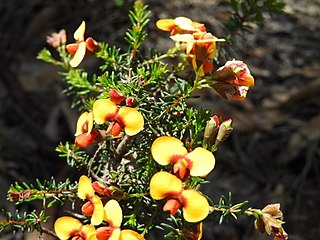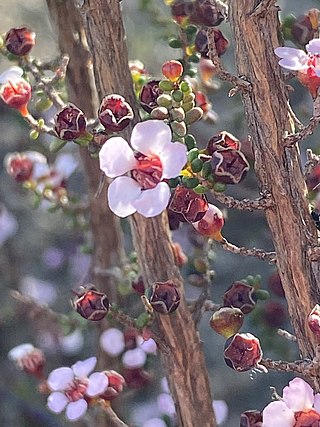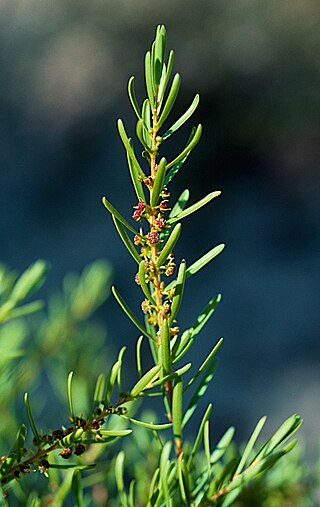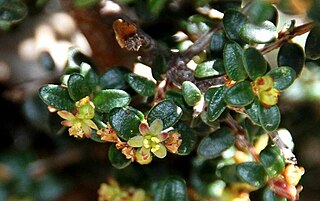
Pseudanthus is a genus of nine species of flowering plants in the family Picrodendraceae, and is endemic to Australia. Plants in the genus Pseudanthus are small, heath-like, monoecious shrubs with simple, leathery leaves, and flowers arranged in upper leaf axils, male flowers usually with three or six stamens and female flowers with three styles.

Dillwynia phylicoides, commonly known as small-leaf parrot-pea, is a species of flowering plant in the family Fabaceae and is endemic to eastern Australia. It is an erect to open shrub with twisted, linear to narrow oblong leaves, and yellow and red flowers.

Rinzia orientalis, commonly known as desert heath-myrtle, is a species of flowering plant in the family Myrtaceae and is endemic to south-eastern Australia. It is a shrub with elliptic to narrowly oblong leaves and white or pale pink flowers usually with ten stamens.

Pseudanthus pimeleoides is a species of flowering plant in the family Picrodendraceae and is endemic to New South Wales. It is a monoecious shrub with crowded, linear to narrowly egg-shaped leaves and creamy white male flowers and inconspicuous female arranged singly in upper leaf axils, but appearing clustered on the ends of branches.

Stachystemon polyandrus is a species of flowering plant in the family Picrodendraceae and is endemic to the southwest of Western Australia. It is a diffuse to straggling, monoecious shrub with crowded, oblong, elliptic or egg-shaped leaves with the narrower end towards the base, and small yellowish-white flowers arranged singly in upper leaf axils, but forming clusters at the ends of branches.
Pseudanthus ballingalliae is a species of flowering plant in the family Picrodendraceae and is endemic to Queensland. It is a monoecious shrub with simple, oblong to narrowly oblong leaves and small yellow male and green female flowers arranged singly in upper leaf axils, but appearing clustered on the ends of branches.

Stachystemon axillaris, commonly known as leafy stachystemon, is a species of flowering plant in the family Picrodendraceae and is endemic to the south-west of Western Australia. It is a monoecious shrub with simple, linear to narrowly elliptic or oblong leaves and small yellow flowers arranged singly in upper leaf axils.

Pseudanthus ligulatus is a species of flowering plant in the family Picrodendraceae and is endemic to northern Queensland. It is a monoecious shrub with simple, lance-shaped or linear to narrowly oblong leaves and creamy white male and pale green female flowers arranged singly in upper leaf axils, but appearing clustered on the ends of branches.
Stachystemon brachyphyllus is a species of flowering plant in the family Picrodendraceae and is endemic to the south-west of Western Australia. It is a monoecious shrub with simple, narrowly elliptic to elliptic or oblong leaves and small yellow, red, purple and brown flowers arranged singly in upper leaf axils.
Pseudanthus micranthus, commonly known as fringed pseudanthus, is a species of flowering plant in the family Picrodendraceae and is endemic to the south-east of South Australia. It is a compact, monoecious shrub with simple, egg-shaped to round leaves and yellow flowers arranged in leaf axils, but appearing clustered on the ends of branches.
Stachystemon intricatus is a species of flowering plant in the family Picrodendraceae and is endemic to the south-west of Western Australia. It is a compact, densely-branched, monoecious shrub with crowded, elliptic or egg-shaped leaves and small, cup-shaped white flowers arranged singly in upper leaf axils.

Brachyloma ciliatum, commonly known as fringed brachyloma or fringed daphne heath, is a species of flowering plant in the family Ericaceae and is endemic to south-eastern Australia. It is a low-lying or erect shrub with upwards-pointing, egg-shaped to oblong leaves and white, tube-shaped flowers.

Pseudanthus orbicularis is a species of flowering plant in the family Picrodendraceae and is endemic to south-eastern continental Australia. It is a compact, monoecious shrub with simple, broadly elliptic to round leaves and creamy white, red or pale red flowers arranged singly in upper leaf axils.
Stachystemon mucronatus is a species of flowering plant in the family Picrodendraceae and is endemic to the south-west of Western Australia. It is a compact, monoecious shrub with narrowly oblong or narrowly elliptic leaves and small, greenish yellow flowers arranged singly in upper leaf axils.

Pseudanthus orientalis is a species of flowering plant in the family Picrodendraceae and is endemic to the coast of eastern Australia. It is a compact, rigid, monoecious shrub with simple, linear to narrowly oblong leaves and yellow to creamy-white flowers arranged singly in upper leaf axils, but often appearing clustered on the ends of branches.
Stachystemon nematophorus is a species of flowering plant in the family Picrodendraceae and is endemic to the Kalbarri National Park in Western Australia. It is a woody, dense, compact, monoecious shrub with simple, oblong, elliptic or egg-shaped leaves with the narrower end towards the base, and small yellowish flowers arranged singly in upper leaf axils, but forming clusters at the ends of branches.
Pseudanthus pauciflorus is a species of flowering plant in the family Picrodendraceae and is endemic to eastern Australia. It is a compact, monoecious shrub with simple, lance-shaped or narrowly elliptic to narrowly oblong leaves and creamy white flowers arranged singly in upper leaf axils, but appearing clustered on the ends of branches.
Stachystemon vermicularis is a species of flowering plant in the family Picrodendraceae and is endemic to the southwest of Western Australia. It is a diffuse, monoecious shrub with linear leaves and small red male flowers and yellowish female flowers arranged singly in upper leaf axils, but forming clusters at the ends of branches.
Stachystemon vinosus is a species of flowering plant in the family Picrodendraceae and is endemic to the southwest of Western Australia. It is a compact, monoecious shrub with narrowly egg-shaped or narrowly oblong leaves and maroon to purplish red and white male flowers and white female flowers arranged singly in upper leaf axils, but forming clusters at the ends of branches.
Stachystemon virgatus is a species of flowering plant in the family Picrodendraceae and is endemic to the southwest of Western Australia. It is a compact monoecious shrub with elliptic or narrowly oblong leaves and small yellow flowers arranged singly in upper leaf axils.









